Factors Affecting Employee Motivation in Barclays: A Detailed Report
VerifiedAdded on 2021/09/27
|15
|4668
|79
Report
AI Summary
This business report investigates the factors influencing employee motivation within Barclays. The study explores the impact of work environment and compensation on employee performance and job satisfaction. It examines the motivational drives, morale, and relevant theories, including Maslow's hierarchy and Herzberg's two-factor theory. Data was collected from Barclays employees and management to identify key motivators. The findings highlight the significance of work environment and compensation in driving employee motivation. The report recommends that Barclays prioritize creating a positive work environment to enhance employee satisfaction and overall bank efficiency. The report includes an executive summary, literature review, methodology, results, and conclusions with recommendations for Barclays to improve employee motivation.
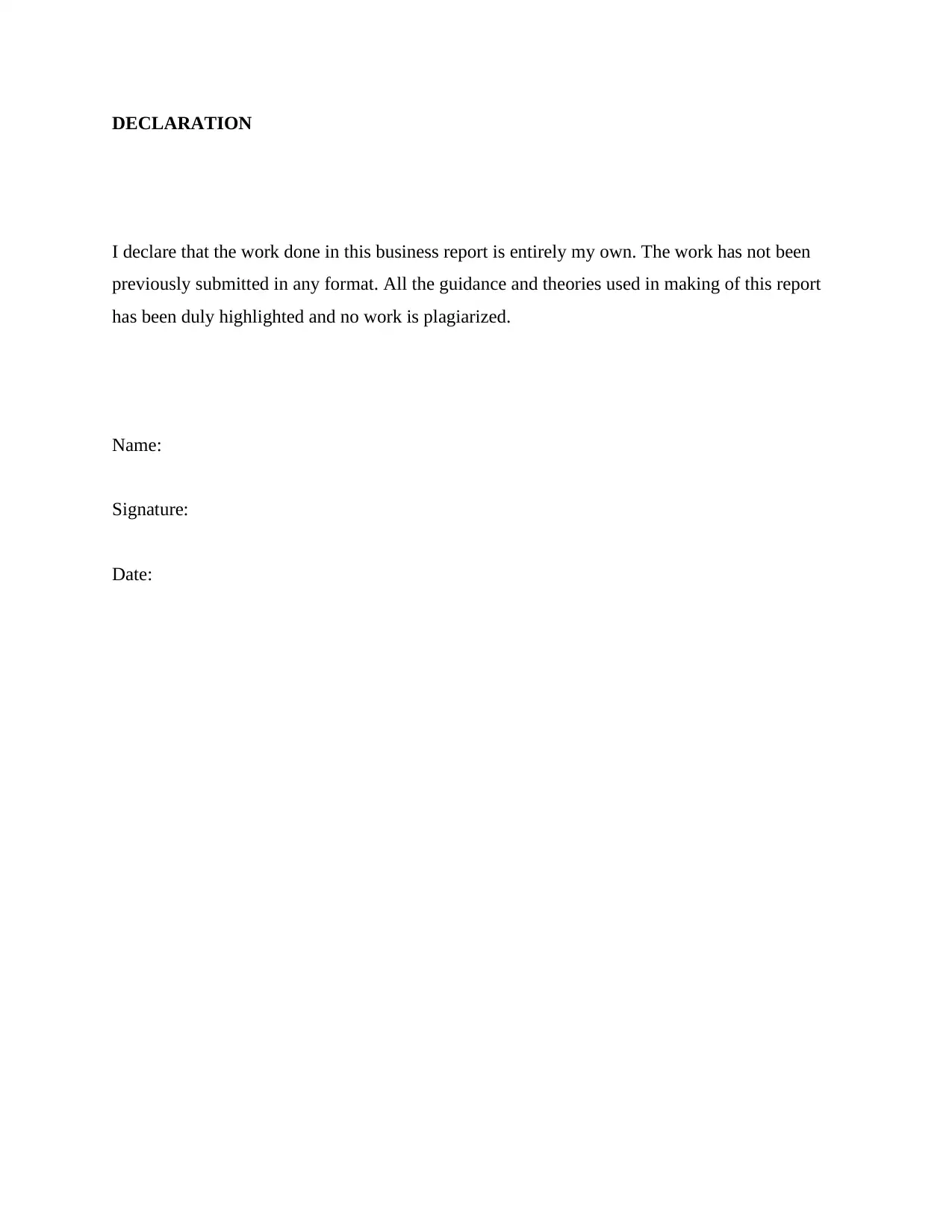
DECLARATION
I declare that the work done in this business report is entirely my own. The work has not been
previously submitted in any format. All the guidance and theories used in making of this report
has been duly highlighted and no work is plagiarized.
Name:
Signature:
Date:
I declare that the work done in this business report is entirely my own. The work has not been
previously submitted in any format. All the guidance and theories used in making of this report
has been duly highlighted and no work is plagiarized.
Name:
Signature:
Date:
Paraphrase This Document
Need a fresh take? Get an instant paraphrase of this document with our AI Paraphraser

ACKNOWLEDGMENTS
I would like to thank my instructor for the tremendous support that he provided throughout the
project. This project would not have been completed without the tireless efforts of my friends
who helped in carrying out the primary research and were a source of constant support for me.
Lastly I would like to thank my parents, to whom I owe everything to.
I would like to thank my instructor for the tremendous support that he provided throughout the
project. This project would not have been completed without the tireless efforts of my friends
who helped in carrying out the primary research and were a source of constant support for me.
Lastly I would like to thank my parents, to whom I owe everything to.
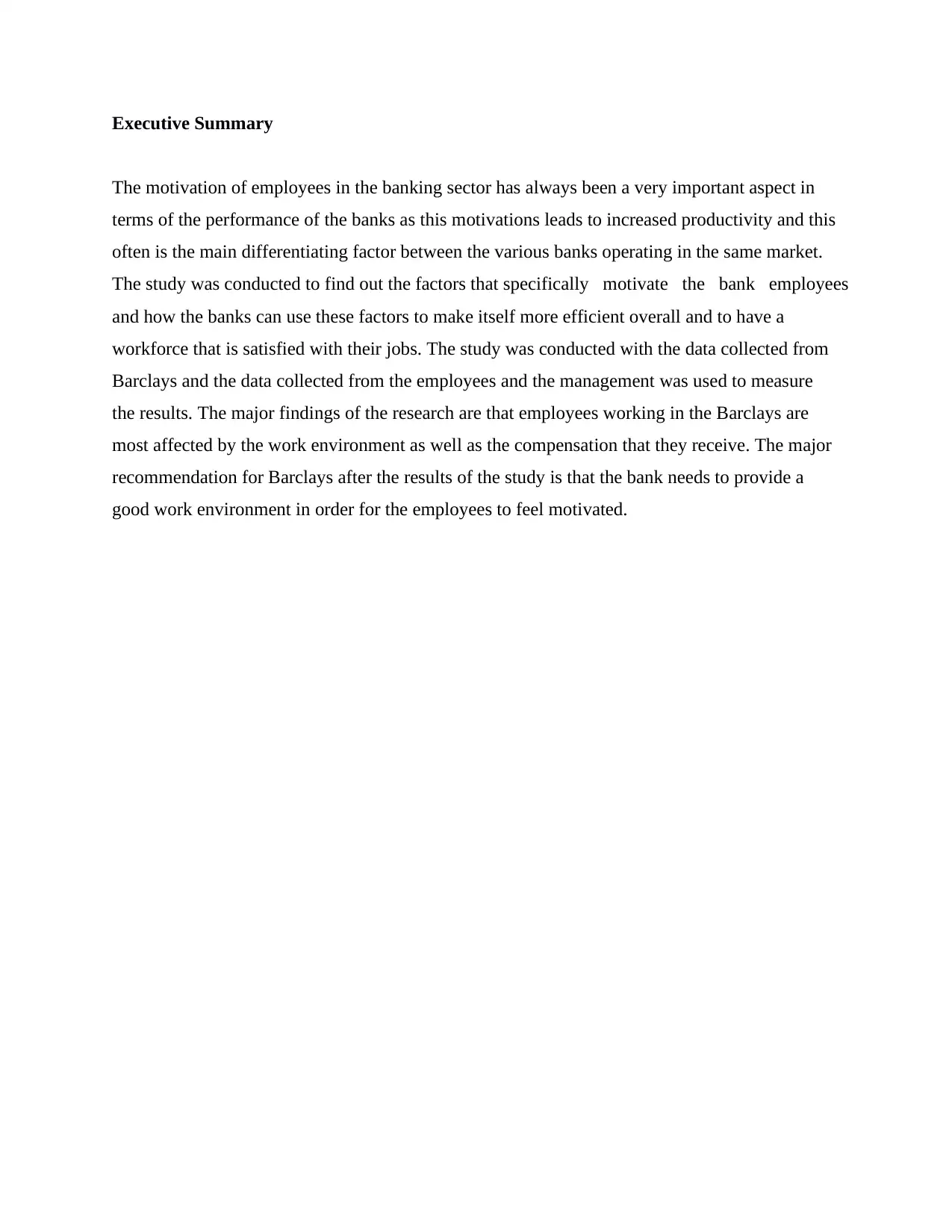
Executive Summary
The motivation of employees in the banking sector has always been a very important aspect in
terms of the performance of the banks as this motivations leads to increased productivity and this
often is the main differentiating factor between the various banks operating in the same market.
The study was conducted to find out the factors that specifically motivate the bank employees
and how the banks can use these factors to make itself more efficient overall and to have a
workforce that is satisfied with their jobs. The study was conducted with the data collected from
Barclays and the data collected from the employees and the management was used to measure
the results. The major findings of the research are that employees working in the Barclays are
most affected by the work environment as well as the compensation that they receive. The major
recommendation for Barclays after the results of the study is that the bank needs to provide a
good work environment in order for the employees to feel motivated.
The motivation of employees in the banking sector has always been a very important aspect in
terms of the performance of the banks as this motivations leads to increased productivity and this
often is the main differentiating factor between the various banks operating in the same market.
The study was conducted to find out the factors that specifically motivate the bank employees
and how the banks can use these factors to make itself more efficient overall and to have a
workforce that is satisfied with their jobs. The study was conducted with the data collected from
Barclays and the data collected from the employees and the management was used to measure
the results. The major findings of the research are that employees working in the Barclays are
most affected by the work environment as well as the compensation that they receive. The major
recommendation for Barclays after the results of the study is that the bank needs to provide a
good work environment in order for the employees to feel motivated.
⊘ This is a preview!⊘
Do you want full access?
Subscribe today to unlock all pages.

Trusted by 1+ million students worldwide
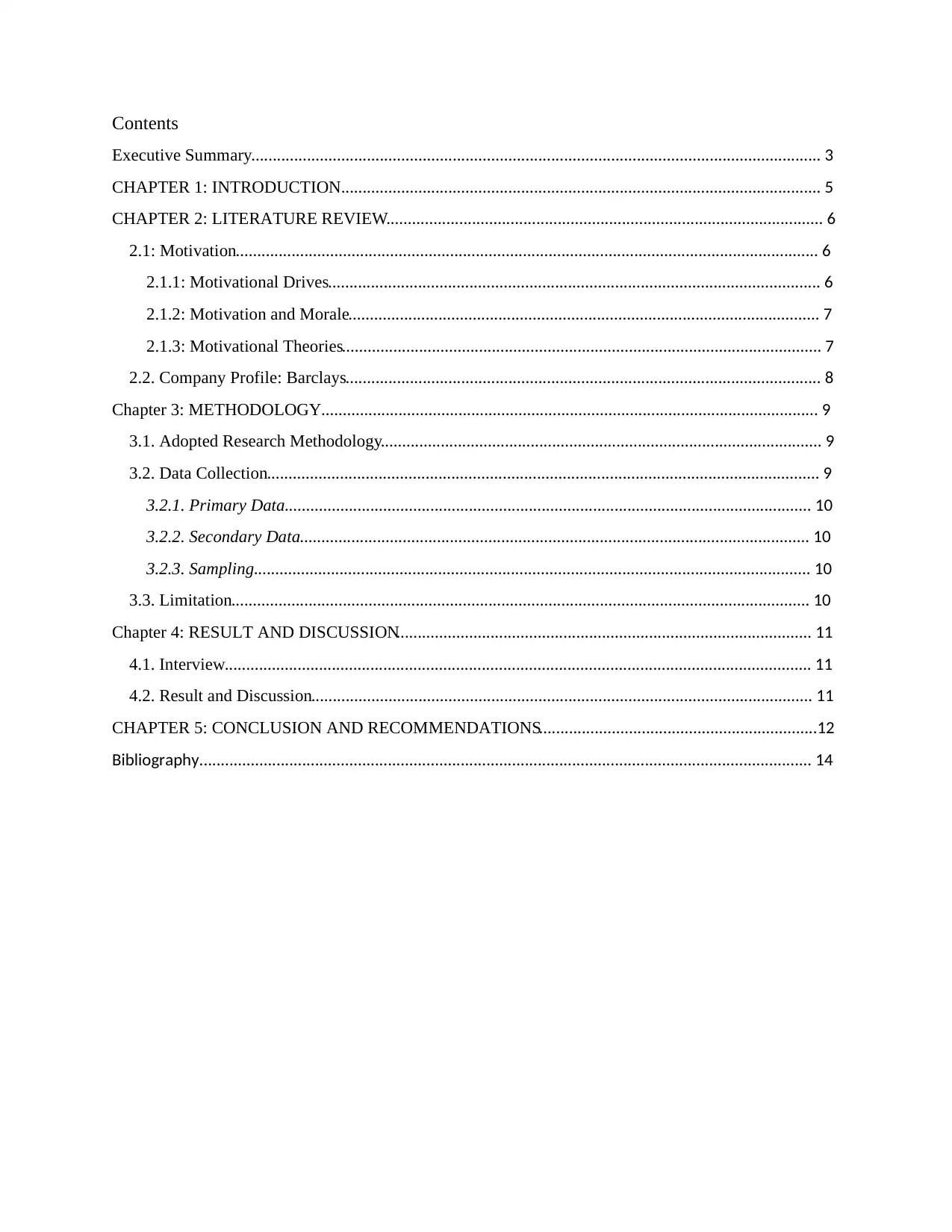
Contents
Executive Summary..................................................................................................................................... 3
CHAPTER 1: INTRODUCTION................................................................................................................ 5
CHAPTER 2: LITERATURE REVIEW...................................................................................................... 6
2.1: Motivation........................................................................................................................................ 6
2.1.1: Motivational Drives................................................................................................................... 6
2.1.2: Motivation and Morale.............................................................................................................. 7
2.1.3: Motivational Theories................................................................................................................ 7
2.2. Company Profile: Barclays............................................................................................................... 8
Chapter 3: METHODOLOGY.................................................................................................................... 9
3.1. Adopted Research Methodology....................................................................................................... 9
3.2. Data Collection................................................................................................................................. 9
3.2.1. Primary Data........................................................................................................................... 10
3.2.2. Secondary Data....................................................................................................................... 10
3.2.3. Sampling.................................................................................................................................. 10
3.3. Limitation....................................................................................................................................... 10
Chapter 4: RESULT AND DISCUSSION................................................................................................. 11
4.1. Interview......................................................................................................................................... 11
4.2. Result and Discussion..................................................................................................................... 11
CHAPTER 5: CONCLUSION AND RECOMMENDATIONS.................................................................12
Bibliography............................................................................................................................................... 14
Executive Summary..................................................................................................................................... 3
CHAPTER 1: INTRODUCTION................................................................................................................ 5
CHAPTER 2: LITERATURE REVIEW...................................................................................................... 6
2.1: Motivation........................................................................................................................................ 6
2.1.1: Motivational Drives................................................................................................................... 6
2.1.2: Motivation and Morale.............................................................................................................. 7
2.1.3: Motivational Theories................................................................................................................ 7
2.2. Company Profile: Barclays............................................................................................................... 8
Chapter 3: METHODOLOGY.................................................................................................................... 9
3.1. Adopted Research Methodology....................................................................................................... 9
3.2. Data Collection................................................................................................................................. 9
3.2.1. Primary Data........................................................................................................................... 10
3.2.2. Secondary Data....................................................................................................................... 10
3.2.3. Sampling.................................................................................................................................. 10
3.3. Limitation....................................................................................................................................... 10
Chapter 4: RESULT AND DISCUSSION................................................................................................. 11
4.1. Interview......................................................................................................................................... 11
4.2. Result and Discussion..................................................................................................................... 11
CHAPTER 5: CONCLUSION AND RECOMMENDATIONS.................................................................12
Bibliography............................................................................................................................................... 14
Paraphrase This Document
Need a fresh take? Get an instant paraphrase of this document with our AI Paraphraser
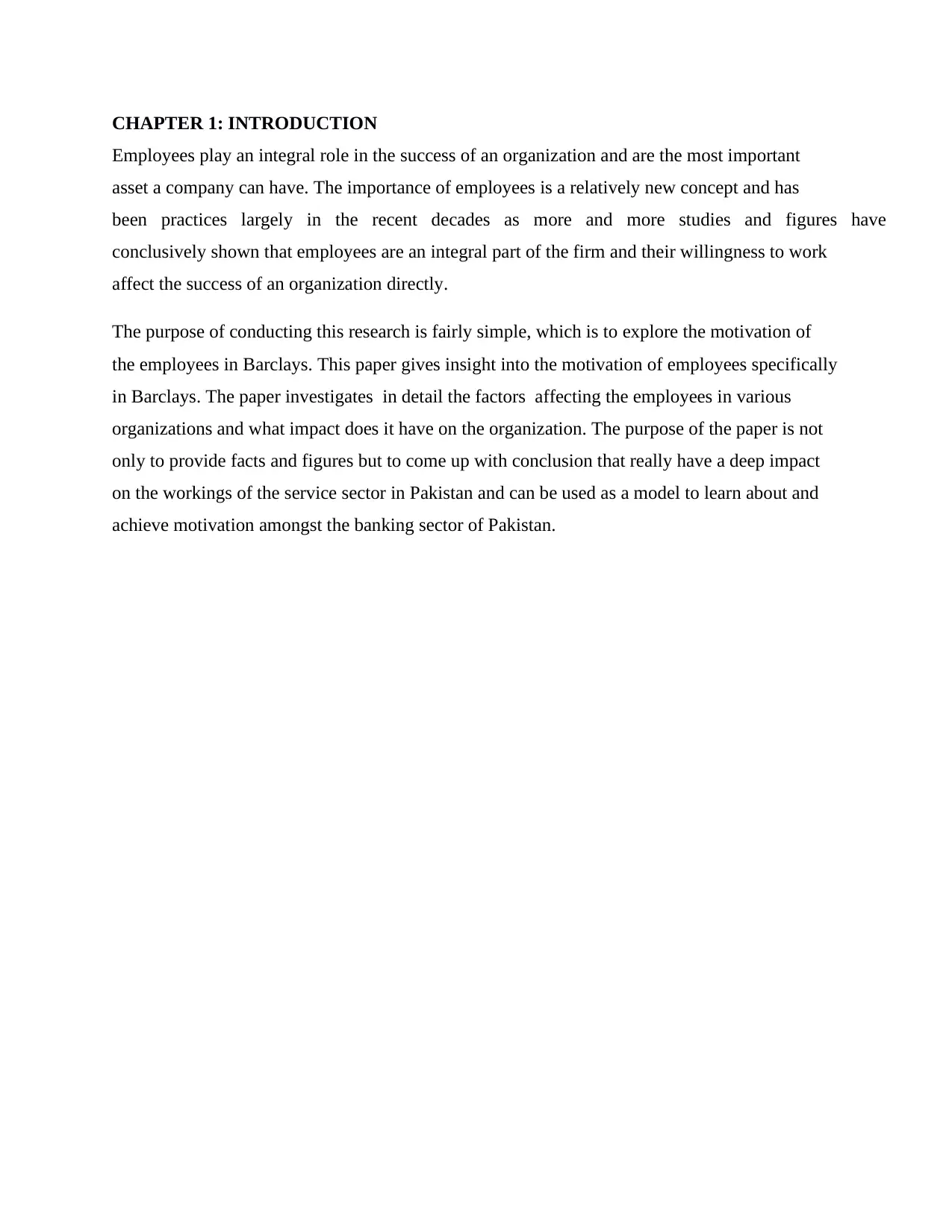
CHAPTER 1: INTRODUCTION
Employees play an integral role in the success of an organization and are the most important
asset a company can have. The importance of employees is a relatively new concept and has
been practices largely in the recent decades as more and more studies and figures have
conclusively shown that employees are an integral part of the firm and their willingness to work
affect the success of an organization directly.
The purpose of conducting this research is fairly simple, which is to explore the motivation of
the employees in Barclays. This paper gives insight into the motivation of employees specifically
in Barclays. The paper investigates in detail the factors affecting the employees in various
organizations and what impact does it have on the organization. The purpose of the paper is not
only to provide facts and figures but to come up with conclusion that really have a deep impact
on the workings of the service sector in Pakistan and can be used as a model to learn about and
achieve motivation amongst the banking sector of Pakistan.
Employees play an integral role in the success of an organization and are the most important
asset a company can have. The importance of employees is a relatively new concept and has
been practices largely in the recent decades as more and more studies and figures have
conclusively shown that employees are an integral part of the firm and their willingness to work
affect the success of an organization directly.
The purpose of conducting this research is fairly simple, which is to explore the motivation of
the employees in Barclays. This paper gives insight into the motivation of employees specifically
in Barclays. The paper investigates in detail the factors affecting the employees in various
organizations and what impact does it have on the organization. The purpose of the paper is not
only to provide facts and figures but to come up with conclusion that really have a deep impact
on the workings of the service sector in Pakistan and can be used as a model to learn about and
achieve motivation amongst the banking sector of Pakistan.
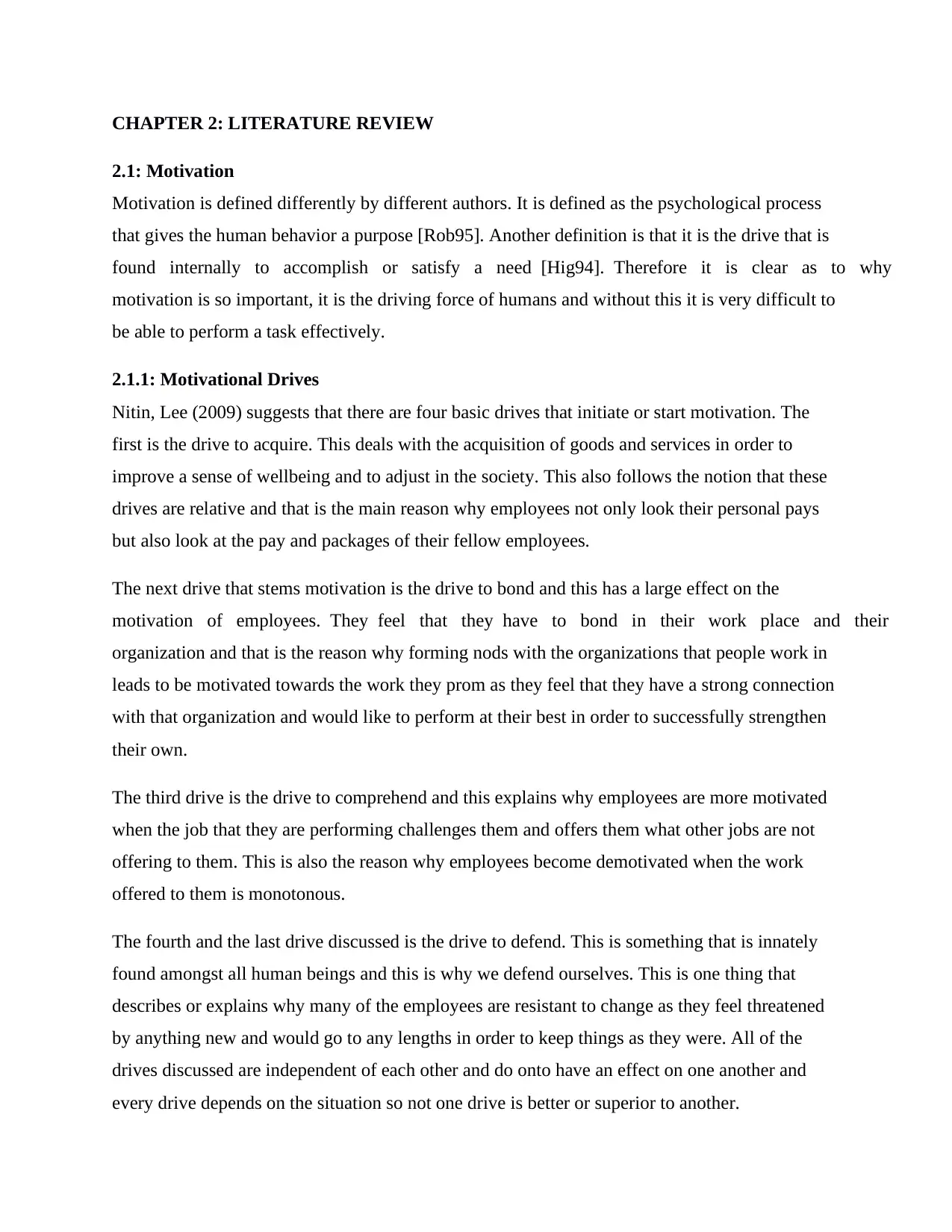
CHAPTER 2: LITERATURE REVIEW
2.1: Motivation
Motivation is defined differently by different authors. It is defined as the psychological process
that gives the human behavior a purpose [Rob95]. Another definition is that it is the drive that is
found internally to accomplish or satisfy a need [Hig94]. Therefore it is clear as to why
motivation is so important, it is the driving force of humans and without this it is very difficult to
be able to perform a task effectively.
2.1.1: Motivational Drives
Nitin, Lee (2009) suggests that there are four basic drives that initiate or start motivation. The
first is the drive to acquire. This deals with the acquisition of goods and services in order to
improve a sense of wellbeing and to adjust in the society. This also follows the notion that these
drives are relative and that is the main reason why employees not only look their personal pays
but also look at the pay and packages of their fellow employees.
The next drive that stems motivation is the drive to bond and this has a large effect on the
motivation of employees. They feel that they have to bond in their work place and their
organization and that is the reason why forming nods with the organizations that people work in
leads to be motivated towards the work they prom as they feel that they have a strong connection
with that organization and would like to perform at their best in order to successfully strengthen
their own.
The third drive is the drive to comprehend and this explains why employees are more motivated
when the job that they are performing challenges them and offers them what other jobs are not
offering to them. This is also the reason why employees become demotivated when the work
offered to them is monotonous.
The fourth and the last drive discussed is the drive to defend. This is something that is innately
found amongst all human beings and this is why we defend ourselves. This is one thing that
describes or explains why many of the employees are resistant to change as they feel threatened
by anything new and would go to any lengths in order to keep things as they were. All of the
drives discussed are independent of each other and do onto have an effect on one another and
every drive depends on the situation so not one drive is better or superior to another.
2.1: Motivation
Motivation is defined differently by different authors. It is defined as the psychological process
that gives the human behavior a purpose [Rob95]. Another definition is that it is the drive that is
found internally to accomplish or satisfy a need [Hig94]. Therefore it is clear as to why
motivation is so important, it is the driving force of humans and without this it is very difficult to
be able to perform a task effectively.
2.1.1: Motivational Drives
Nitin, Lee (2009) suggests that there are four basic drives that initiate or start motivation. The
first is the drive to acquire. This deals with the acquisition of goods and services in order to
improve a sense of wellbeing and to adjust in the society. This also follows the notion that these
drives are relative and that is the main reason why employees not only look their personal pays
but also look at the pay and packages of their fellow employees.
The next drive that stems motivation is the drive to bond and this has a large effect on the
motivation of employees. They feel that they have to bond in their work place and their
organization and that is the reason why forming nods with the organizations that people work in
leads to be motivated towards the work they prom as they feel that they have a strong connection
with that organization and would like to perform at their best in order to successfully strengthen
their own.
The third drive is the drive to comprehend and this explains why employees are more motivated
when the job that they are performing challenges them and offers them what other jobs are not
offering to them. This is also the reason why employees become demotivated when the work
offered to them is monotonous.
The fourth and the last drive discussed is the drive to defend. This is something that is innately
found amongst all human beings and this is why we defend ourselves. This is one thing that
describes or explains why many of the employees are resistant to change as they feel threatened
by anything new and would go to any lengths in order to keep things as they were. All of the
drives discussed are independent of each other and do onto have an effect on one another and
every drive depends on the situation so not one drive is better or superior to another.
⊘ This is a preview!⊘
Do you want full access?
Subscribe today to unlock all pages.

Trusted by 1+ million students worldwide
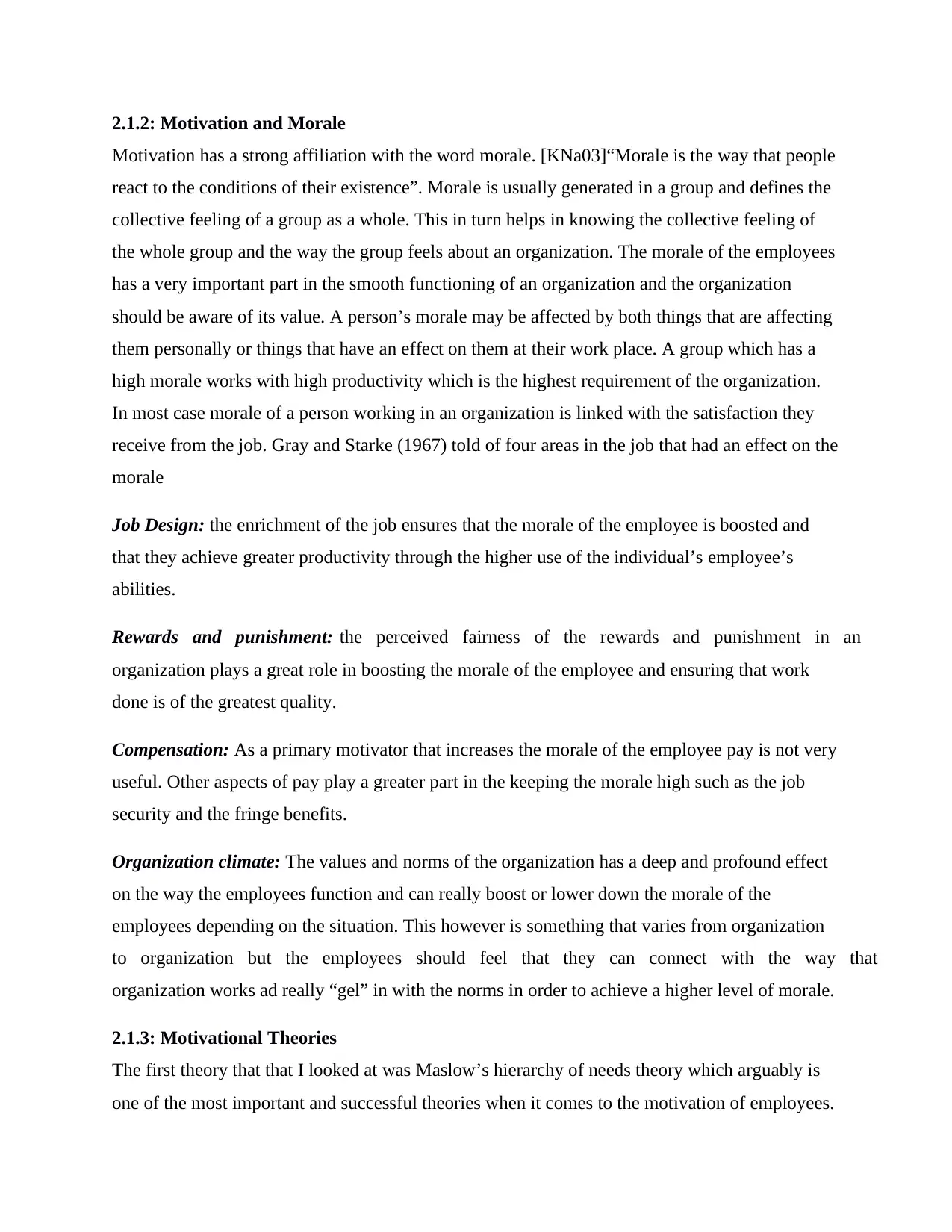
2.1.2: Motivation and Morale
Motivation has a strong affiliation with the word morale. [KNa03]“Morale is the way that people
react to the conditions of their existence”. Morale is usually generated in a group and defines the
collective feeling of a group as a whole. This in turn helps in knowing the collective feeling of
the whole group and the way the group feels about an organization. The morale of the employees
has a very important part in the smooth functioning of an organization and the organization
should be aware of its value. A person’s morale may be affected by both things that are affecting
them personally or things that have an effect on them at their work place. A group which has a
high morale works with high productivity which is the highest requirement of the organization.
In most case morale of a person working in an organization is linked with the satisfaction they
receive from the job. Gray and Starke (1967) told of four areas in the job that had an effect on the
morale
Job Design: the enrichment of the job ensures that the morale of the employee is boosted and
that they achieve greater productivity through the higher use of the individual’s employee’s
abilities.
Rewards and punishment: the perceived fairness of the rewards and punishment in an
organization plays a great role in boosting the morale of the employee and ensuring that work
done is of the greatest quality.
Compensation: As a primary motivator that increases the morale of the employee pay is not very
useful. Other aspects of pay play a greater part in the keeping the morale high such as the job
security and the fringe benefits.
Organization climate: The values and norms of the organization has a deep and profound effect
on the way the employees function and can really boost or lower down the morale of the
employees depending on the situation. This however is something that varies from organization
to organization but the employees should feel that they can connect with the way that
organization works ad really “gel” in with the norms in order to achieve a higher level of morale.
2.1.3: Motivational Theories
The first theory that that I looked at was Maslow’s hierarchy of needs theory which arguably is
one of the most important and successful theories when it comes to the motivation of employees.
Motivation has a strong affiliation with the word morale. [KNa03]“Morale is the way that people
react to the conditions of their existence”. Morale is usually generated in a group and defines the
collective feeling of a group as a whole. This in turn helps in knowing the collective feeling of
the whole group and the way the group feels about an organization. The morale of the employees
has a very important part in the smooth functioning of an organization and the organization
should be aware of its value. A person’s morale may be affected by both things that are affecting
them personally or things that have an effect on them at their work place. A group which has a
high morale works with high productivity which is the highest requirement of the organization.
In most case morale of a person working in an organization is linked with the satisfaction they
receive from the job. Gray and Starke (1967) told of four areas in the job that had an effect on the
morale
Job Design: the enrichment of the job ensures that the morale of the employee is boosted and
that they achieve greater productivity through the higher use of the individual’s employee’s
abilities.
Rewards and punishment: the perceived fairness of the rewards and punishment in an
organization plays a great role in boosting the morale of the employee and ensuring that work
done is of the greatest quality.
Compensation: As a primary motivator that increases the morale of the employee pay is not very
useful. Other aspects of pay play a greater part in the keeping the morale high such as the job
security and the fringe benefits.
Organization climate: The values and norms of the organization has a deep and profound effect
on the way the employees function and can really boost or lower down the morale of the
employees depending on the situation. This however is something that varies from organization
to organization but the employees should feel that they can connect with the way that
organization works ad really “gel” in with the norms in order to achieve a higher level of morale.
2.1.3: Motivational Theories
The first theory that that I looked at was Maslow’s hierarchy of needs theory which arguably is
one of the most important and successful theories when it comes to the motivation of employees.
Paraphrase This Document
Need a fresh take? Get an instant paraphrase of this document with our AI Paraphraser
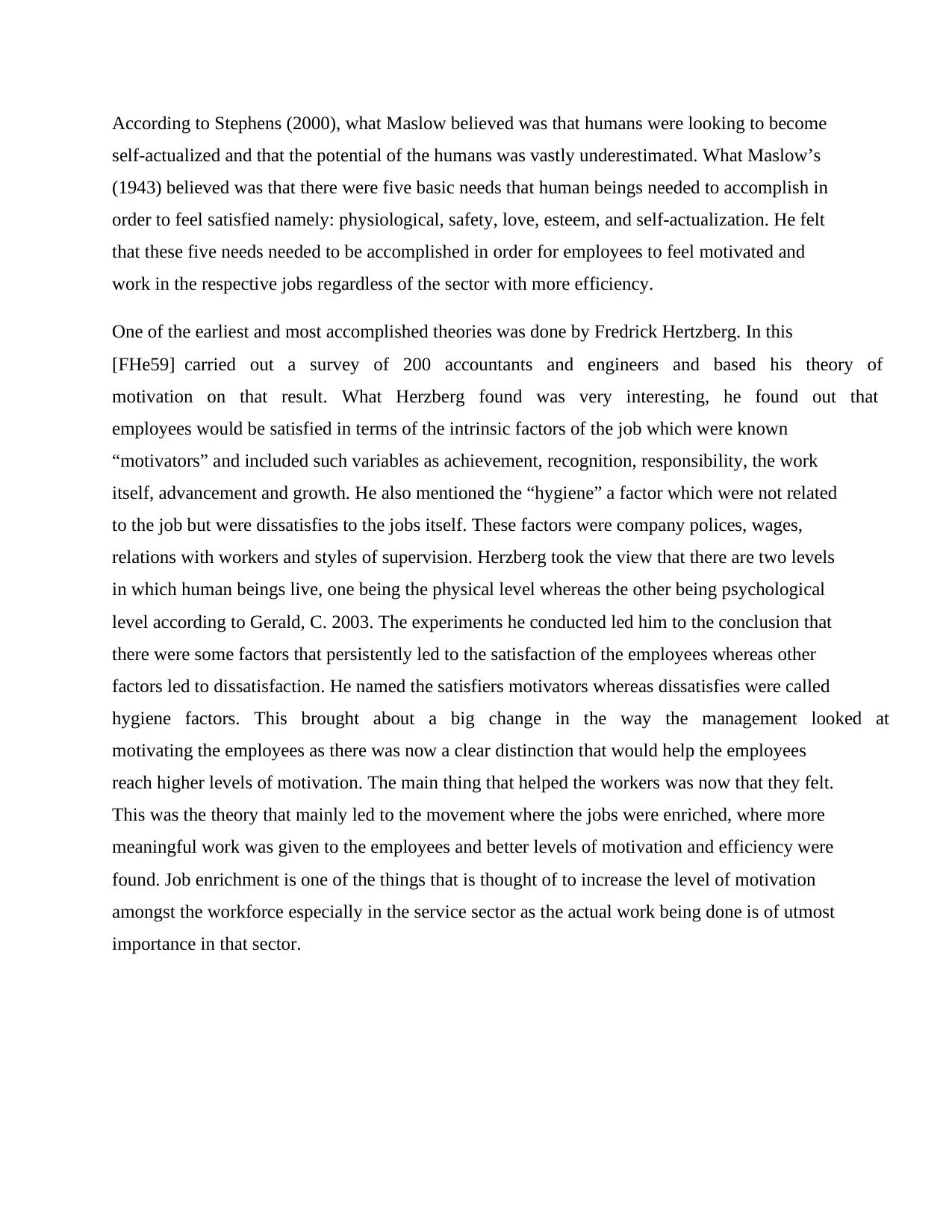
According to Stephens (2000), what Maslow believed was that humans were looking to become
self-actualized and that the potential of the humans was vastly underestimated. What Maslow’s
(1943) believed was that there were five basic needs that human beings needed to accomplish in
order to feel satisfied namely: physiological, safety, love, esteem, and self-actualization. He felt
that these five needs needed to be accomplished in order for employees to feel motivated and
work in the respective jobs regardless of the sector with more efficiency.
One of the earliest and most accomplished theories was done by Fredrick Hertzberg. In this
[FHe59] carried out a survey of 200 accountants and engineers and based his theory of
motivation on that result. What Herzberg found was very interesting, he found out that
employees would be satisfied in terms of the intrinsic factors of the job which were known
“motivators” and included such variables as achievement, recognition, responsibility, the work
itself, advancement and growth. He also mentioned the “hygiene” a factor which were not related
to the job but were dissatisfies to the jobs itself. These factors were company polices, wages,
relations with workers and styles of supervision. Herzberg took the view that there are two levels
in which human beings live, one being the physical level whereas the other being psychological
level according to Gerald, C. 2003. The experiments he conducted led him to the conclusion that
there were some factors that persistently led to the satisfaction of the employees whereas other
factors led to dissatisfaction. He named the satisfiers motivators whereas dissatisfies were called
hygiene factors. This brought about a big change in the way the management looked at
motivating the employees as there was now a clear distinction that would help the employees
reach higher levels of motivation. The main thing that helped the workers was now that they felt.
This was the theory that mainly led to the movement where the jobs were enriched, where more
meaningful work was given to the employees and better levels of motivation and efficiency were
found. Job enrichment is one of the things that is thought of to increase the level of motivation
amongst the workforce especially in the service sector as the actual work being done is of utmost
importance in that sector.
self-actualized and that the potential of the humans was vastly underestimated. What Maslow’s
(1943) believed was that there were five basic needs that human beings needed to accomplish in
order to feel satisfied namely: physiological, safety, love, esteem, and self-actualization. He felt
that these five needs needed to be accomplished in order for employees to feel motivated and
work in the respective jobs regardless of the sector with more efficiency.
One of the earliest and most accomplished theories was done by Fredrick Hertzberg. In this
[FHe59] carried out a survey of 200 accountants and engineers and based his theory of
motivation on that result. What Herzberg found was very interesting, he found out that
employees would be satisfied in terms of the intrinsic factors of the job which were known
“motivators” and included such variables as achievement, recognition, responsibility, the work
itself, advancement and growth. He also mentioned the “hygiene” a factor which were not related
to the job but were dissatisfies to the jobs itself. These factors were company polices, wages,
relations with workers and styles of supervision. Herzberg took the view that there are two levels
in which human beings live, one being the physical level whereas the other being psychological
level according to Gerald, C. 2003. The experiments he conducted led him to the conclusion that
there were some factors that persistently led to the satisfaction of the employees whereas other
factors led to dissatisfaction. He named the satisfiers motivators whereas dissatisfies were called
hygiene factors. This brought about a big change in the way the management looked at
motivating the employees as there was now a clear distinction that would help the employees
reach higher levels of motivation. The main thing that helped the workers was now that they felt.
This was the theory that mainly led to the movement where the jobs were enriched, where more
meaningful work was given to the employees and better levels of motivation and efficiency were
found. Job enrichment is one of the things that is thought of to increase the level of motivation
amongst the workforce especially in the service sector as the actual work being done is of utmost
importance in that sector.
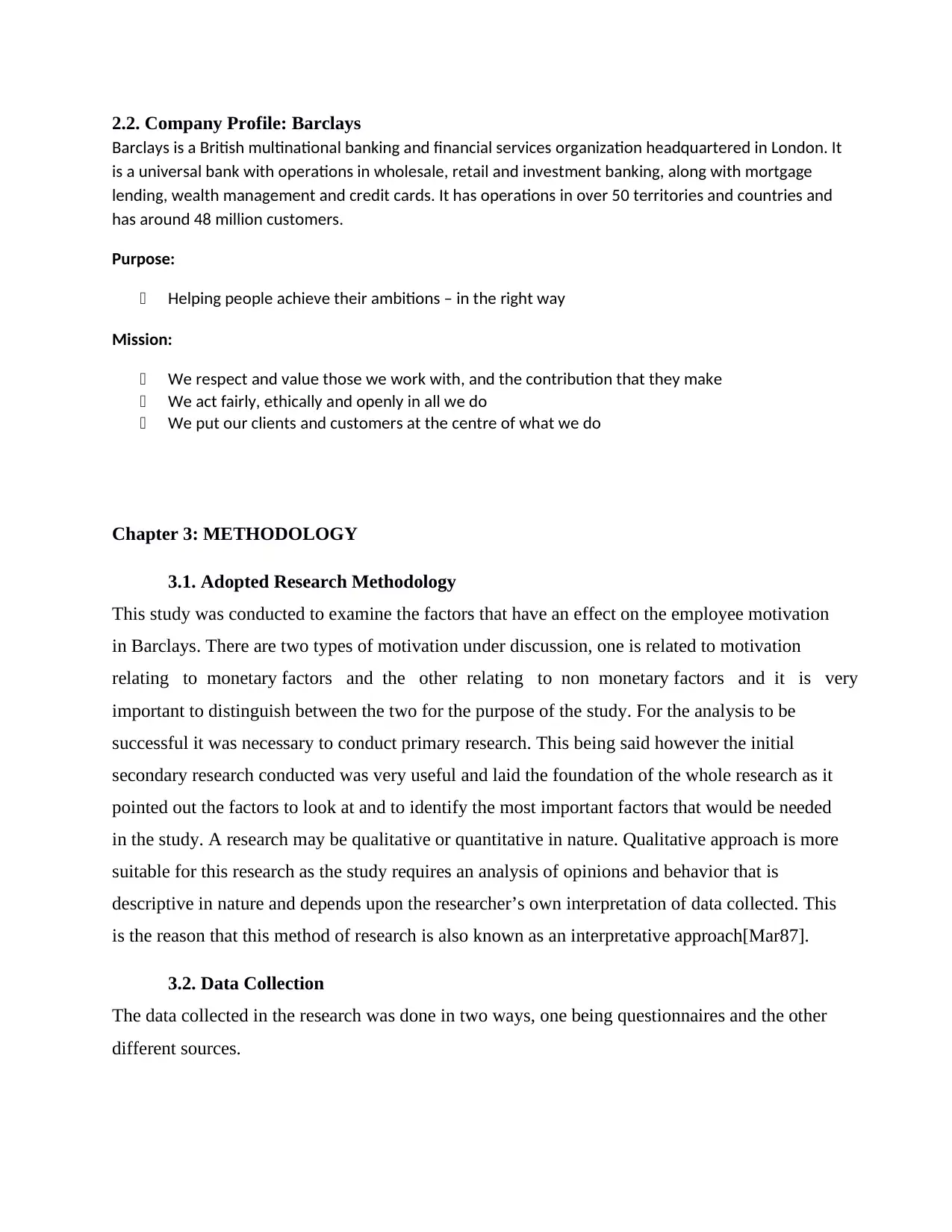
2.2. Company Profile: Barclays
Barclays is a British multinational banking and financial services organization headquartered in London. It
is a universal bank with operations in wholesale, retail and investment banking, along with mortgage
lending, wealth management and credit cards. It has operations in over 50 territories and countries and
has around 48 million customers.
Purpose:
Helping people achieve their ambitions – in the right way
Mission:
We respect and value those we work with, and the contribution that they make
We act fairly, ethically and openly in all we do
We put our clients and customers at the centre of what we do
Chapter 3: METHODOLOGY
3.1. Adopted Research Methodology
This study was conducted to examine the factors that have an effect on the employee motivation
in Barclays. There are two types of motivation under discussion, one is related to motivation
relating to monetary factors and the other relating to non monetary factors and it is very
important to distinguish between the two for the purpose of the study. For the analysis to be
successful it was necessary to conduct primary research. This being said however the initial
secondary research conducted was very useful and laid the foundation of the whole research as it
pointed out the factors to look at and to identify the most important factors that would be needed
in the study. A research may be qualitative or quantitative in nature. Qualitative approach is more
suitable for this research as the study requires an analysis of opinions and behavior that is
descriptive in nature and depends upon the researcher’s own interpretation of data collected. This
is the reason that this method of research is also known as an interpretative approach[Mar87].
3.2. Data Collection
The data collected in the research was done in two ways, one being questionnaires and the other
different sources.
Barclays is a British multinational banking and financial services organization headquartered in London. It
is a universal bank with operations in wholesale, retail and investment banking, along with mortgage
lending, wealth management and credit cards. It has operations in over 50 territories and countries and
has around 48 million customers.
Purpose:
Helping people achieve their ambitions – in the right way
Mission:
We respect and value those we work with, and the contribution that they make
We act fairly, ethically and openly in all we do
We put our clients and customers at the centre of what we do
Chapter 3: METHODOLOGY
3.1. Adopted Research Methodology
This study was conducted to examine the factors that have an effect on the employee motivation
in Barclays. There are two types of motivation under discussion, one is related to motivation
relating to monetary factors and the other relating to non monetary factors and it is very
important to distinguish between the two for the purpose of the study. For the analysis to be
successful it was necessary to conduct primary research. This being said however the initial
secondary research conducted was very useful and laid the foundation of the whole research as it
pointed out the factors to look at and to identify the most important factors that would be needed
in the study. A research may be qualitative or quantitative in nature. Qualitative approach is more
suitable for this research as the study requires an analysis of opinions and behavior that is
descriptive in nature and depends upon the researcher’s own interpretation of data collected. This
is the reason that this method of research is also known as an interpretative approach[Mar87].
3.2. Data Collection
The data collected in the research was done in two ways, one being questionnaires and the other
different sources.
⊘ This is a preview!⊘
Do you want full access?
Subscribe today to unlock all pages.

Trusted by 1+ million students worldwide
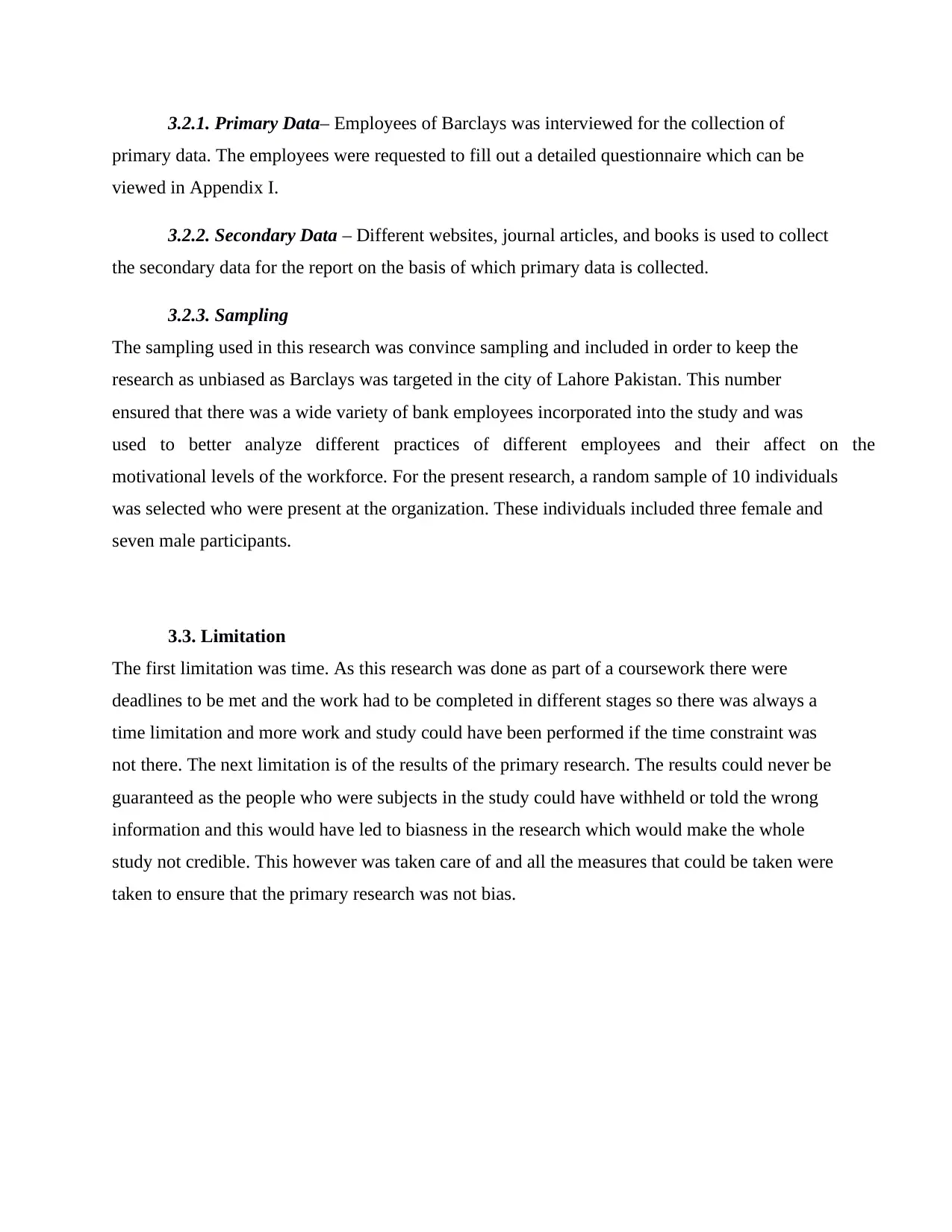
3.2.1. Primary Data– Employees of Barclays was interviewed for the collection of
primary data. The employees were requested to fill out a detailed questionnaire which can be
viewed in Appendix I.
3.2.2. Secondary Data – Different websites, journal articles, and books is used to collect
the secondary data for the report on the basis of which primary data is collected.
3.2.3. Sampling
The sampling used in this research was convince sampling and included in order to keep the
research as unbiased as Barclays was targeted in the city of Lahore Pakistan. This number
ensured that there was a wide variety of bank employees incorporated into the study and was
used to better analyze different practices of different employees and their affect on the
motivational levels of the workforce. For the present research, a random sample of 10 individuals
was selected who were present at the organization. These individuals included three female and
seven male participants.
3.3. Limitation
The first limitation was time. As this research was done as part of a coursework there were
deadlines to be met and the work had to be completed in different stages so there was always a
time limitation and more work and study could have been performed if the time constraint was
not there. The next limitation is of the results of the primary research. The results could never be
guaranteed as the people who were subjects in the study could have withheld or told the wrong
information and this would have led to biasness in the research which would make the whole
study not credible. This however was taken care of and all the measures that could be taken were
taken to ensure that the primary research was not bias.
primary data. The employees were requested to fill out a detailed questionnaire which can be
viewed in Appendix I.
3.2.2. Secondary Data – Different websites, journal articles, and books is used to collect
the secondary data for the report on the basis of which primary data is collected.
3.2.3. Sampling
The sampling used in this research was convince sampling and included in order to keep the
research as unbiased as Barclays was targeted in the city of Lahore Pakistan. This number
ensured that there was a wide variety of bank employees incorporated into the study and was
used to better analyze different practices of different employees and their affect on the
motivational levels of the workforce. For the present research, a random sample of 10 individuals
was selected who were present at the organization. These individuals included three female and
seven male participants.
3.3. Limitation
The first limitation was time. As this research was done as part of a coursework there were
deadlines to be met and the work had to be completed in different stages so there was always a
time limitation and more work and study could have been performed if the time constraint was
not there. The next limitation is of the results of the primary research. The results could never be
guaranteed as the people who were subjects in the study could have withheld or told the wrong
information and this would have led to biasness in the research which would make the whole
study not credible. This however was taken care of and all the measures that could be taken were
taken to ensure that the primary research was not bias.
Paraphrase This Document
Need a fresh take? Get an instant paraphrase of this document with our AI Paraphraser
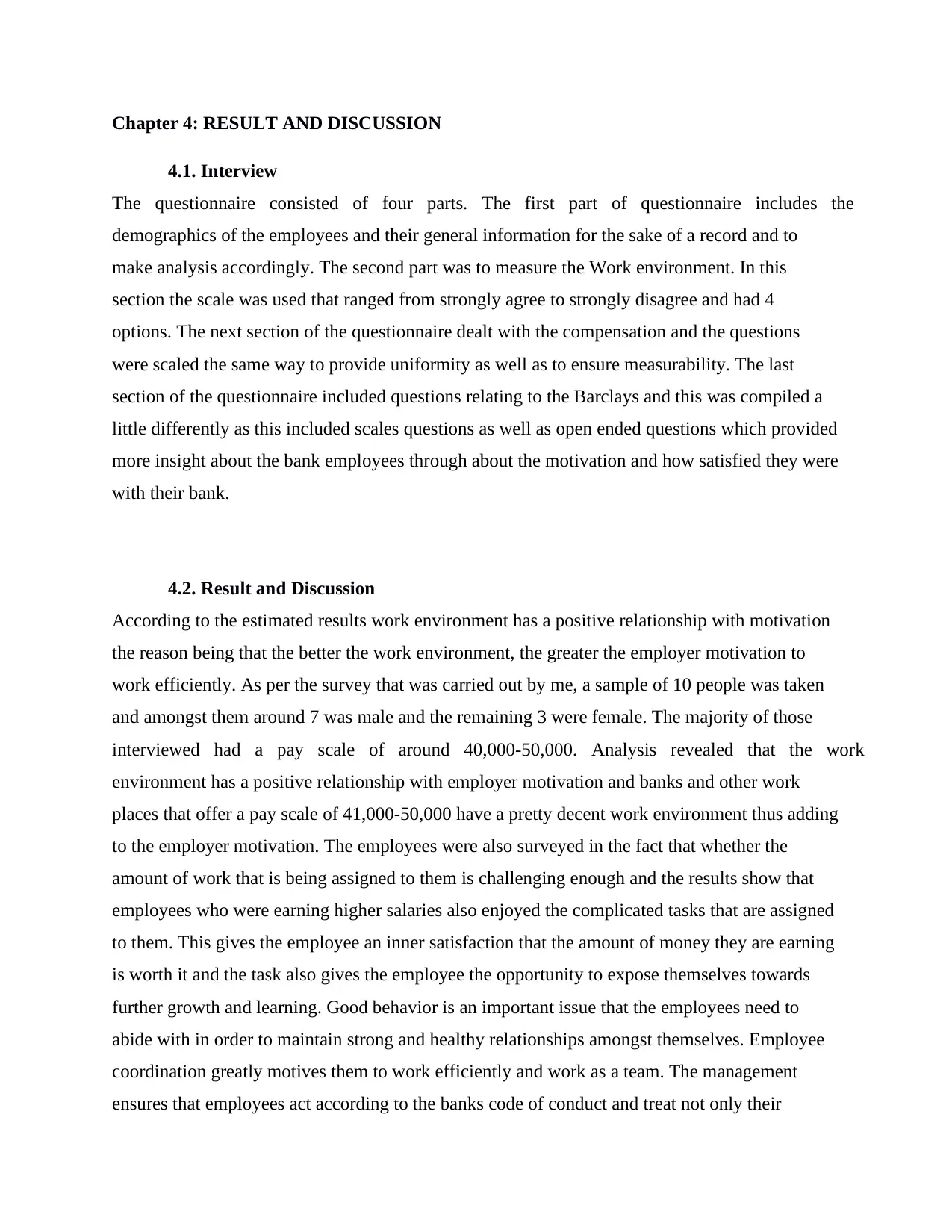
Chapter 4: RESULT AND DISCUSSION
4.1. Interview
The questionnaire consisted of four parts. The first part of questionnaire includes the
demographics of the employees and their general information for the sake of a record and to
make analysis accordingly. The second part was to measure the Work environment. In this
section the scale was used that ranged from strongly agree to strongly disagree and had 4
options. The next section of the questionnaire dealt with the compensation and the questions
were scaled the same way to provide uniformity as well as to ensure measurability. The last
section of the questionnaire included questions relating to the Barclays and this was compiled a
little differently as this included scales questions as well as open ended questions which provided
more insight about the bank employees through about the motivation and how satisfied they were
with their bank.
4.2. Result and Discussion
According to the estimated results work environment has a positive relationship with motivation
the reason being that the better the work environment, the greater the employer motivation to
work efficiently. As per the survey that was carried out by me, a sample of 10 people was taken
and amongst them around 7 was male and the remaining 3 were female. The majority of those
interviewed had a pay scale of around 40,000-50,000. Analysis revealed that the work
environment has a positive relationship with employer motivation and banks and other work
places that offer a pay scale of 41,000-50,000 have a pretty decent work environment thus adding
to the employer motivation. The employees were also surveyed in the fact that whether the
amount of work that is being assigned to them is challenging enough and the results show that
employees who were earning higher salaries also enjoyed the complicated tasks that are assigned
to them. This gives the employee an inner satisfaction that the amount of money they are earning
is worth it and the task also gives the employee the opportunity to expose themselves towards
further growth and learning. Good behavior is an important issue that the employees need to
abide with in order to maintain strong and healthy relationships amongst themselves. Employee
coordination greatly motives them to work efficiently and work as a team. The management
ensures that employees act according to the banks code of conduct and treat not only their
4.1. Interview
The questionnaire consisted of four parts. The first part of questionnaire includes the
demographics of the employees and their general information for the sake of a record and to
make analysis accordingly. The second part was to measure the Work environment. In this
section the scale was used that ranged from strongly agree to strongly disagree and had 4
options. The next section of the questionnaire dealt with the compensation and the questions
were scaled the same way to provide uniformity as well as to ensure measurability. The last
section of the questionnaire included questions relating to the Barclays and this was compiled a
little differently as this included scales questions as well as open ended questions which provided
more insight about the bank employees through about the motivation and how satisfied they were
with their bank.
4.2. Result and Discussion
According to the estimated results work environment has a positive relationship with motivation
the reason being that the better the work environment, the greater the employer motivation to
work efficiently. As per the survey that was carried out by me, a sample of 10 people was taken
and amongst them around 7 was male and the remaining 3 were female. The majority of those
interviewed had a pay scale of around 40,000-50,000. Analysis revealed that the work
environment has a positive relationship with employer motivation and banks and other work
places that offer a pay scale of 41,000-50,000 have a pretty decent work environment thus adding
to the employer motivation. The employees were also surveyed in the fact that whether the
amount of work that is being assigned to them is challenging enough and the results show that
employees who were earning higher salaries also enjoyed the complicated tasks that are assigned
to them. This gives the employee an inner satisfaction that the amount of money they are earning
is worth it and the task also gives the employee the opportunity to expose themselves towards
further growth and learning. Good behavior is an important issue that the employees need to
abide with in order to maintain strong and healthy relationships amongst themselves. Employee
coordination greatly motives them to work efficiently and work as a team. The management
ensures that employees act according to the banks code of conduct and treat not only their
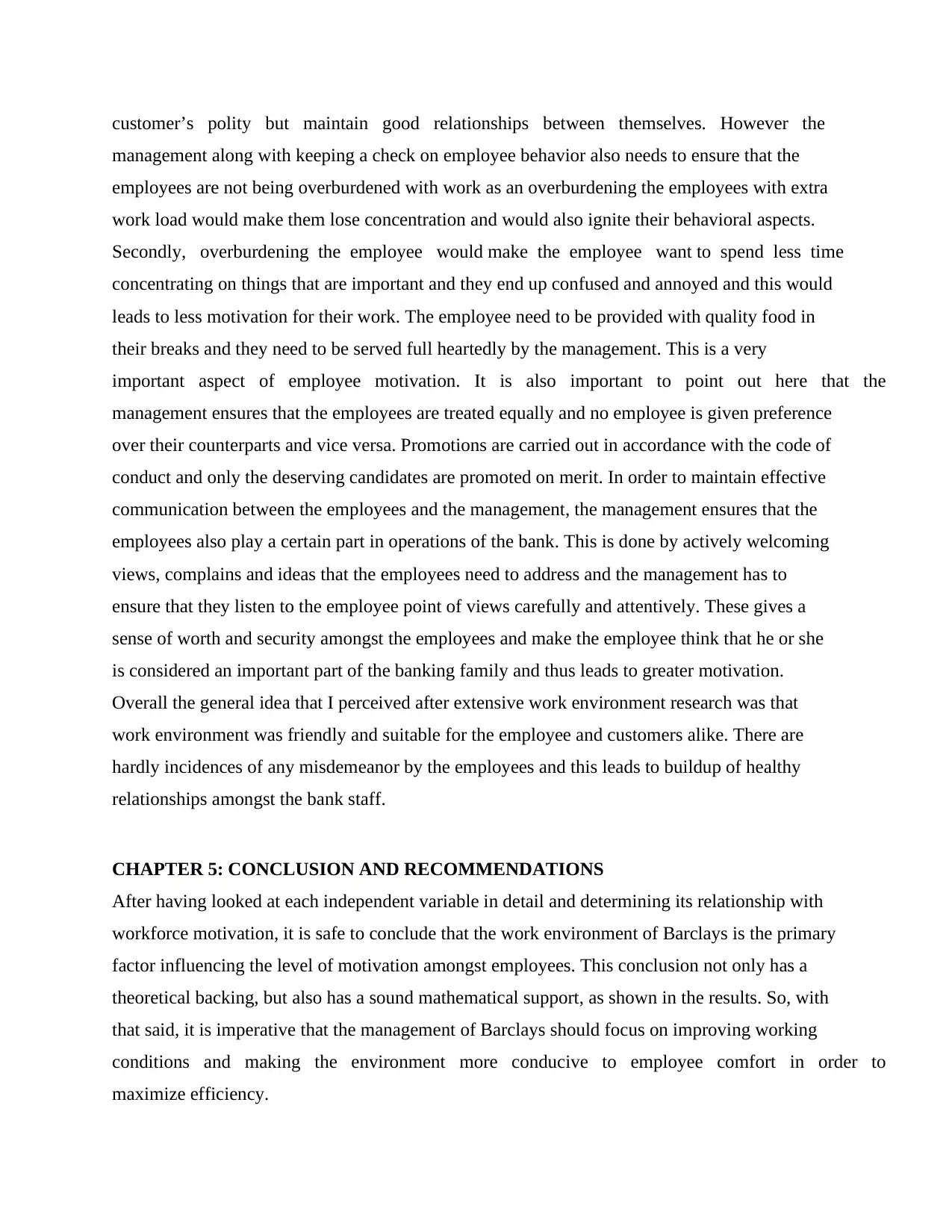
customer’s polity but maintain good relationships between themselves. However the
management along with keeping a check on employee behavior also needs to ensure that the
employees are not being overburdened with work as an overburdening the employees with extra
work load would make them lose concentration and would also ignite their behavioral aspects.
Secondly, overburdening the employee would make the employee want to spend less time
concentrating on things that are important and they end up confused and annoyed and this would
leads to less motivation for their work. The employee need to be provided with quality food in
their breaks and they need to be served full heartedly by the management. This is a very
important aspect of employee motivation. It is also important to point out here that the
management ensures that the employees are treated equally and no employee is given preference
over their counterparts and vice versa. Promotions are carried out in accordance with the code of
conduct and only the deserving candidates are promoted on merit. In order to maintain effective
communication between the employees and the management, the management ensures that the
employees also play a certain part in operations of the bank. This is done by actively welcoming
views, complains and ideas that the employees need to address and the management has to
ensure that they listen to the employee point of views carefully and attentively. These gives a
sense of worth and security amongst the employees and make the employee think that he or she
is considered an important part of the banking family and thus leads to greater motivation.
Overall the general idea that I perceived after extensive work environment research was that
work environment was friendly and suitable for the employee and customers alike. There are
hardly incidences of any misdemeanor by the employees and this leads to buildup of healthy
relationships amongst the bank staff.
CHAPTER 5: CONCLUSION AND RECOMMENDATIONS
After having looked at each independent variable in detail and determining its relationship with
workforce motivation, it is safe to conclude that the work environment of Barclays is the primary
factor influencing the level of motivation amongst employees. This conclusion not only has a
theoretical backing, but also has a sound mathematical support, as shown in the results. So, with
that said, it is imperative that the management of Barclays should focus on improving working
conditions and making the environment more conducive to employee comfort in order to
maximize efficiency.
management along with keeping a check on employee behavior also needs to ensure that the
employees are not being overburdened with work as an overburdening the employees with extra
work load would make them lose concentration and would also ignite their behavioral aspects.
Secondly, overburdening the employee would make the employee want to spend less time
concentrating on things that are important and they end up confused and annoyed and this would
leads to less motivation for their work. The employee need to be provided with quality food in
their breaks and they need to be served full heartedly by the management. This is a very
important aspect of employee motivation. It is also important to point out here that the
management ensures that the employees are treated equally and no employee is given preference
over their counterparts and vice versa. Promotions are carried out in accordance with the code of
conduct and only the deserving candidates are promoted on merit. In order to maintain effective
communication between the employees and the management, the management ensures that the
employees also play a certain part in operations of the bank. This is done by actively welcoming
views, complains and ideas that the employees need to address and the management has to
ensure that they listen to the employee point of views carefully and attentively. These gives a
sense of worth and security amongst the employees and make the employee think that he or she
is considered an important part of the banking family and thus leads to greater motivation.
Overall the general idea that I perceived after extensive work environment research was that
work environment was friendly and suitable for the employee and customers alike. There are
hardly incidences of any misdemeanor by the employees and this leads to buildup of healthy
relationships amongst the bank staff.
CHAPTER 5: CONCLUSION AND RECOMMENDATIONS
After having looked at each independent variable in detail and determining its relationship with
workforce motivation, it is safe to conclude that the work environment of Barclays is the primary
factor influencing the level of motivation amongst employees. This conclusion not only has a
theoretical backing, but also has a sound mathematical support, as shown in the results. So, with
that said, it is imperative that the management of Barclays should focus on improving working
conditions and making the environment more conducive to employee comfort in order to
maximize efficiency.
⊘ This is a preview!⊘
Do you want full access?
Subscribe today to unlock all pages.

Trusted by 1+ million students worldwide
1 out of 15
Related Documents
Your All-in-One AI-Powered Toolkit for Academic Success.
+13062052269
info@desklib.com
Available 24*7 on WhatsApp / Email
![[object Object]](/_next/static/media/star-bottom.7253800d.svg)
Unlock your academic potential
Copyright © 2020–2025 A2Z Services. All Rights Reserved. Developed and managed by ZUCOL.





